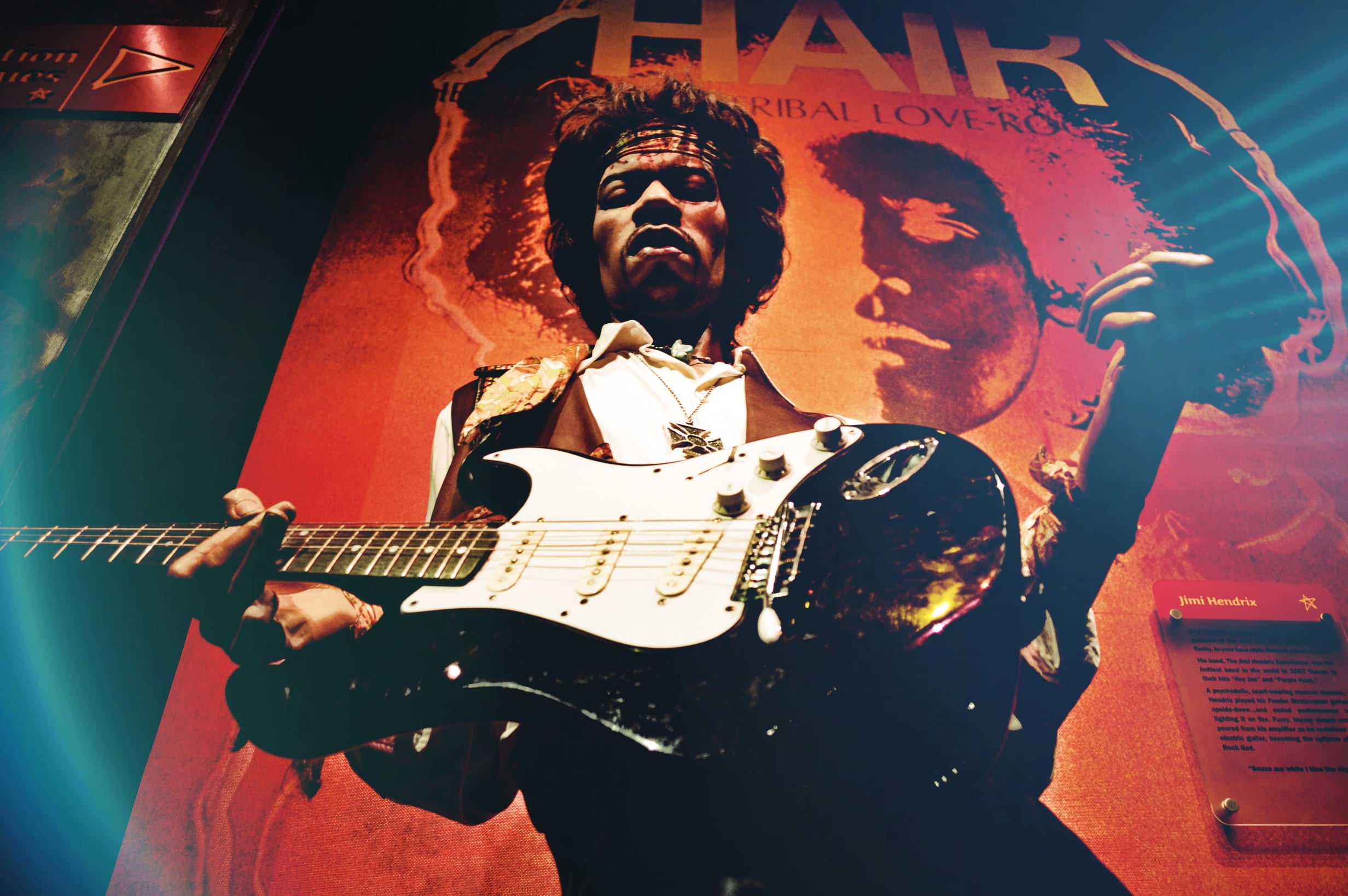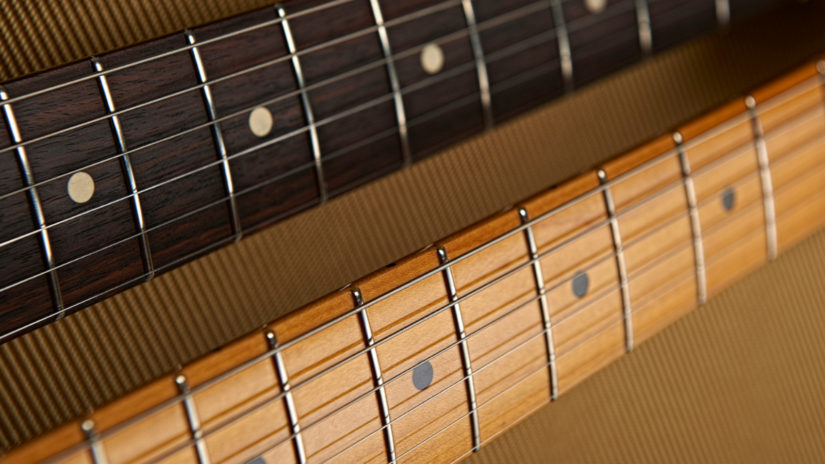.
Which guitar is better? The one with the light neck or the one with the dark neck?
The difference between blacks and whites also exists in the guitar market. Each type has unique qualities that make it an attractive option for guitarists. There will be guitarists who prefer the maple neck and others who prefer the rosewood. On the other hand, we will always find guitarists who will prefer both to experience the different tonal qualities each offers, for diversity purposes.
In general, Maple is used for cheaper models of guitars because it is easier to work with than other types of wood, making it ideal for beginners. You can find quite a few guitarists who play guitars with rosewood necks, even though they are among the maple fans, and this is only for aesthetic reasons, given the fact that Maple tends to store finger grease on the board and creates a dirty look.
Since, in rare cases, you can find acoustic and classical guitars with a maple neck, that is, a fretboard made of light-colored Maple, in this article, I will comprehensively review the importance and differences in the types of necks available in an electric guitar and how this affects the quality of the sound and the playing experience.
Few guitarists know that the guitar’s neck has a dominant and decisive meaning on the guitar’s sound. At the same time, many believe that the sound source originates from the type of wood that belongs to the guitar’s body, the pickups, the electronics, and the type of guitar.
Many components affect the tone of the electric guitar that is used through amplification, unlike an acoustic or classical guitar that relies on natural acoustic resonance; in the case of the electric guitar, the “resonance” will be a derivative of the type of neck and this can only be diagnosed when the guitar is amplified.

Generally, when deciding to purchase an electric guitar, the guitarist must pay attention to two important elements: the comfort of playing through the neck of the guitar and the type of sound affected by the fingerboard due to the differences in the wood. The comfort of playing is the main, important, and determining element that will affect the playing duration over time. There are four types of necks, which differ in diameter and shape and affect the comfort of the grip: C-shape, U-shape, V-shape, and D-shape. The most popular types are the C-shape and the D-shape.
The D-shape is flat compared to the C-shape. The D-shape has square shoulders, and the C-shape has rounded shoulders. The C-shape is universally considered the most comfortable among many guitarists. The D-shape is very popular for Shredding style and fast playing that exists mostly in the rock and metal genre and sometimes in the country and is suitable for guitarists who anchor the thumb on the back of the neck.
The second component is the sound, which is often influenced by the fretboard and changes the tone of the sound depending on the type of wood. In this case, many people think that only guitarists with sharp ears will be able to distinguish between the types of sound that vary between Maple and Rosewood.
Still, any of you who have never held a guitar will be able to pay attention to the subtleties and even identify in the future by hearing which guitar was played in each song. It’s quite noticeable.
The rosewood board is porous, while the Maple is usually sealed due to the nature of the type of wood, and sometimes, an additional layer is added that provides complete sealing through a varnish coating on the fretboard’s surface.
Rosewood boards generally have a warm, sweet tone that softens the guitar’s overall sound and provides a great deal of depth due to its porous nature, allowing it to absorb high tones.
Tone
On the other hand, Maple is defined as an extremely dense type of wood known for its crisp and piercing sound that produces sharp and well-defined sounds and has a bright, crisp, and fresh tone that can cut through the mix, making it perfect for many guitarists.
Despite the differences in tone between the rosewood and Maple, if you are a guitarist, I recommend you examine the matter first by watching YouTube videos to sharpen your discernment and make you feel what sound you are drawn to.
After that, look for electric guitars for sale with a maple neck and a rosewood neck in second-hand boards and check the matter without committing to a purchase. Finally, do the same test at musical instrument stores, where you can get a better perspective due to the selection. Try both types or ask the seller to play each To test the sound quality from an unbiased source.
There may be a situation where you will be attracted to the sound of the Maple, which will sound more crunchy and refreshing than the rosewood. Still, the grip on it will be less comfortable than the rosewood neck, and what is important is the quality and comfort of the grip, which will give you confidence in the moment of truth and help you play in a balanced way without fighting for every chord, lick, scale or A solo piece.
I assume some of you are parents of children who do not understand between the two types. Therefore, it would be good to learn the differences by watching videos and letting your child decide for himself, even if the choice is due to color and not professional considerations.
The video in front of you clearly shows the differences in sound between the two types for illustrative purposes:
Another way to experience the sound is to listen to famous guitarists who play on rosewood and maple. It is important to listen to the guitar’s clean sound without effects polluting the natural texture.
For example, David Gilmour and Eric Clapton often play a Fender Strat with a maple neck as their first choice.
On the other hand, Stevie Ray Vaughan and Jimi Hendrix mostly played a Fender Strat with a rosewood neck.




The feeling at the moment of truth
Many guitarists often feel the differences between the different fretboard surfaces. The porous rosewood surface is, in most cases, naturally oily, which gives it a smoother and more fluid feel when playing. On the other hand, Maple can be a bit sticky in the lacquer coating shell or the finish and polish of the neck and may be found uncomfortable for this reason.
There is another type of Maple known as “roast maple.” It is a special type of Maple that has been roasted until it reaches the optimal moisture level, and the roasting process increases the wood’s stability, making it more resistant to changes in temperature and humidity and flowing smoothly when playing.
Maintenance

The correct way to maintain the guitar (and, of course, the cheapest and most profitable) is to clean the neck of the guitar weekly with a cloth and lemon oil intended for cleaning the surfaces of the guitar’s fretboard.
In both cases, the maple and the rosewood, it is a simple operation that takes a few minutes. Certain chemicals not specifically designed for cleaning guitar surfaces can be harmful if they come into direct contact with the wood.
This is a simple operation that takes a few minutes. Certain chemicals not specifically designed for cleaning guitar surfaces can be harmful if they come into direct contact with the wood.
Keep Rokin


